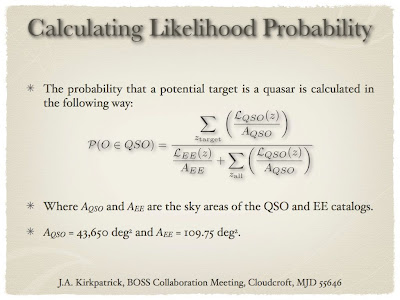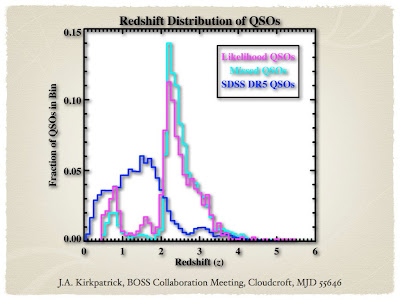I downloaded the latest BOSS data and randoms from Will Percival as Martin White suggested in my email exchange with him yesterday.
There are in the following location on the wiki:
https://trac.sdss3.org/wiki/BOSS/clustering/cats
I put them here on riemann:
/clusterfs/riemann/raid001/jessica/boss/
galaxy-wjp-main008-LOWZ-020211-cut.txt
random-wjp-main008-LOWZ-020211-cut-small.txt
galaxy-wjp-merge-CMASS-020211-cut.txt
random-wjp-merge-CMASS-020211-cut-small.txt
The format of these files is:
ra / degrees
dec / degrees
redshift
galaxy weight
sector completeness
close pair flag
THING_ID
MASK POLY ID
ID for galaxy in spAll file (not in std format)
I read them in and below are plots. As you can see, the distribution of the randoms matches the data. So there is something wrong with what I am doing. At this point though, I'm not going to waste more time trying to fix my masks/randoms. I'm going to use these catalogs and re-run the correlation functions to see if this fixes things.
I'm also going to ask Shirley or Eric to run a correlation function on the same data to check that we get the same answer.








The code to make the above plots is in the following log file:
../logs/110302log/pro
thisfile = '/clusterfs/riemann/raid001/jessica/boss/galaxy-wjp-main008-LOWZ-020211-cut.txt'
readcol,thisfile,slra,sldec,slz,x,x,x,x,x,x,format='(F,F,F,F,F,F,F,F,F)'
thisfile = '/clusterfs/riemann/raid001/jessica/boss/galaxy-wjp-merge-CMASS-020211-cut.txt'
readcol,thisfile,sra,sdec,sz,x,x,x,x,x,x,format='(F,F,F,F,F,F,F,F,F)'
sra = [sra,slra]
sdec = [sdec,sldec]
sz = [sz,slz]
thisfile = '/clusterfs/riemann/raid001/jessica/boss/random-wjp-main008-LOWZ-020211-cut-small.txt'
readcol,thisfile,rslra,rsldec,rslz,x,x,x,x,x,x,format='(F,F,F,F,F,F,F,F,F)'
thisfile = '/clusterfs/riemann/raid001/jessica/boss/random-wjp-merge-CMASS-020211-cut-small.txt'
readcol,thisfile,rsra,rsdec,rsz,x,x,x,x,x,x,format='(F,F,F,F,F,F,F,F,F)'
rsra = [rsra,rslra]
rsdec = [rsdec,rsldec]
rsz = [rsz,rslz]
xtit = 'Ra'
ytit = 'Dec'
mtit = 'Ra vs Dec'
window,xsize=700,ysize=600
plot, sra, sdec, ps = 3, xrange = [110,130], yrange=[40,55],XTITLE = xtit, YTITLE =ytit, TITLE = mtit, charsize = 1.5, charthick = 1
oplot, rsra, rsdec, ps=3, color = fsc_color('green')
;Make histogram of the dec distributions
data = sdec
datamin = min(sdec)
datamax = max(sdec)
binsize = (datamax - datamin)/100
xtit = 'Dec Distribution'
ytit = '% in bin'
mtit = 'Histogram of Spectroscopic Dec'
window,xsize=700,ysize=600
hist = HISTOGRAM(data, binsize = binsize, min = datamin, max = datamax)
bins = FINDGEN(N_ELEMENTS(hist))*binsize + datamin
plot, bins, hist*1.0/n_elements(data), PSYM = 10, xrange = [datamin,datamax], yrange=[0,1.0*max(hist)/n_elements(data)],XTITLE = xtit, YTITLE =ytit, TITLE = mtit, charsize = 1.5, charthick = 1
data = rsdec
datamin = min(rsdec)
datamax = max(rsdec)
hist = HISTOGRAM(data, binsize = binsize, min = datamin, max = datamax)
bins = FINDGEN(N_ELEMENTS(hist))*binsize + datamin
oplot, bins, 1.0*hist/n_elements(data), PSYM = 10, color = fsc_color('green')
;Make histogram of the dec distributions
data = sdec
datamin = min(sdec)
datamax = max(sdec)
binsize = (datamax - datamin)/1000
xtit = 'Dec Distribution'
ytit = '# in bin'
mtit = 'Histogram of Spectroscopic Dec'
window,xsize=700,ysize=600
hist = HISTOGRAM(data, binsize = binsize, min = datamin, max = datamax)
bins = FINDGEN(N_ELEMENTS(hist))*binsize + datamin
plot, bins, hist*1.0, PSYM = 10, xrange = [datamin,datamax], yrange=[0,1.0*max(hist)],XTITLE = xtit, YTITLE =ytit, TITLE = mtit, charsize = 1.5, charthick = 1
data = rsdec
datamin = min(rsdec)
datamax = max(rsdec)
hist = HISTOGRAM(data, binsize = binsize, min = datamin, max = datamax)
bins = FINDGEN(N_ELEMENTS(hist))*binsize + datamin
oplot, bins, 1.0*hist, PSYM = 10, color = fsc_color('green')
;Make histogram of the dec distributions
data = sra
datamin = min(sra)
datamax = max(sra)
binsize = (datamax - datamin)/100
xtit = 'Ra Distribution'
ytit = '% in bin'
mtit = 'Histogram of Spectroscopic Ra'
window,xsize=700,ysize=600
hist = HISTOGRAM(data, binsize = binsize, min = datamin, max = datamax)
bins = FINDGEN(N_ELEMENTS(hist))*binsize + datamin
plot, bins, hist*1.0/n_elements(data), PSYM = 10, xrange = [datamin,datamax], yrange=[0,1.0*max(hist)/n_elements(data)],XTITLE = xtit, YTITLE =ytit, TITLE = mtit, charsize = 1.5, charthick = 1
data = rsra
datamin = min(rsra)
datamax = max(rsra)
hist = HISTOGRAM(data, binsize = binsize, min = datamin, max = datamax)
bins = FINDGEN(N_ELEMENTS(hist))*binsize + datamin
oplot, bins, 1.0*hist/n_elements(data), PSYM = 10, color = fsc_color('green')
;Make histogram of the dec distributions
data = sra
datamin = min(sra)
datamax = max(sra)
binsize = (datamax - datamin)/1000
xtit = 'RA Distribution'
ytit = '# in bin'
mtit = 'Histogram of Spectroscopic RA'
window,xsize=700,ysize=600
hist = HISTOGRAM(data, binsize = binsize, min = datamin, max = datamax)
bins = FINDGEN(N_ELEMENTS(hist))*binsize + datamin
plot, bins, hist*1.0, PSYM = 10, xrange = [datamin,datamax], yrange=[0,1.0*max(hist)],XTITLE = xtit, YTITLE =ytit, TITLE = mtit, charsize = 1.5, charthick = 1
data = rsra
datamin = min(rsra)
datamax = max(rsra)
hist = HISTOGRAM(data, binsize = binsize, min = datamin, max = datamax)
bins = FINDGEN(N_ELEMENTS(hist))*binsize + datamin
oplot, bins, 1.0*hist, PSYM = 10, color = fsc_color('green')
;Make histogram of the z distributions
data = sz
datamin = min(sz)
datamax = max(sz)
binsize = (datamax - datamin)/50
xtit = 'Redshift Distribution'
ytit = '% in bin'
mtit = 'Histogram of Spectroscopic z'
window,xsize=700,ysize=600
hist = HISTOGRAM(data, binsize = binsize, min = datamin, max = datamax)
bins = FINDGEN(N_ELEMENTS(hist))*binsize + datamin
plot, bins, hist*1.0/n_elements(data), PSYM = 10, xrange = [datamin,datamax], yrange=[0,1.0*max(hist)/n_elements(data)],XTITLE = xtit, YTITLE =ytit, TITLE = mtit, charsize = 1.5, charthick = 1
data = rsz
datamin = min(rsz)
datamax = max(rsz)
hist = HISTOGRAM(data, binsize = binsize, min = datamin, max = datamax)
bins = FINDGEN(N_ELEMENTS(hist))*binsize + datamin
oplot, bins, 1.0*hist/n_elements(data), PSYM = 10, color = fsc_color('green')
;Plot Data that is inside the mask
window,xsize=700,ysize=600
xobject = sra
yobject = sdec
xtit = 'RA'
ytit = 'Dec'
mtit = 'SDSS Spectroscopic Data + Masks'
plot, xobject, yobject, psym=3, symsize=2, XTITLE = xtit, YTITLE = ytit, TITLE = mtit, charsize = 2, charthick = 1, thick = 2, xthick=2, ythick=2
oplot, xobject, yobject, ps=3, color=fsc_color('white')
oplot, rsra, rsdec, ps=3, color=fsc_color('green')
























 As you can see the slope of the function is much shallower for my correlation function, than it is the literature.
As you can see the slope of the function is much shallower for my correlation function, than it is the literature.

 This will take a bit because I am correlating out to such large scales (180 Mpc/h).
This will take a bit because I am correlating out to such large scales (180 Mpc/h).













